Every home chef and food lover knows how important it is to regularly clean and sanitize their kitchen knives.
Cleaning and sanitizing the knife increases its lifespan and durability. More importantly, Knife sterilization also helps to reduce food contamination or prevent food poisoning altogether.
Now, cleaning a knife is pretty straightforward. But I found out that many people do not know when and how to clean their kitchen knives.
In this article, you’ll learn the scenarios under which a knife must be cleaned and sanitized and how to wash various kinds of knives.
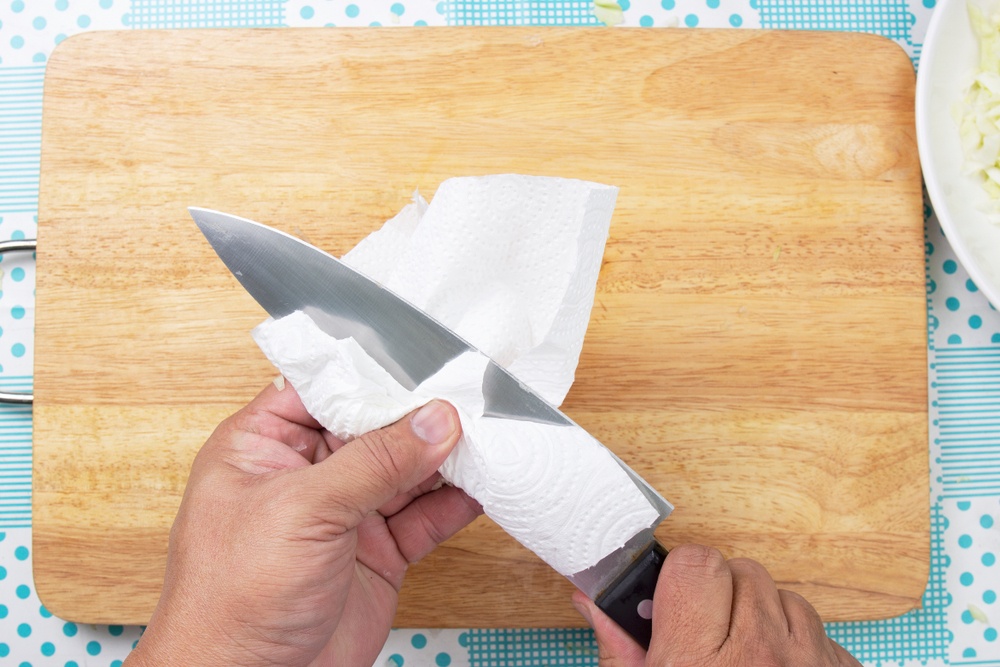
When Must A Knife be Cleaned and Sanitized?
Here are six possible scenarios under which you must clean and sanitize your knife. They include:
1. After Purchasing the Knife
You must clean and sanitize your new knife. We forget about this most times and end up using the new knife directly without cleaning. It is time to stop making such mistakes.
The knife may indeed look spick and span after purchase. However, that does not make it hygienic for direct use. It would help if you washed a new blade, even when purchased from the best kitchen knife brands.
The new knife may likely carry some pathogens (like bacteria and viruses) that may contaminate the food. These pathogens are unseen to the naked eyes. Therefore, the best way to avoid them is to clean and sanitize your new knife after purchase.
It would be best to keep the habit of washing new kitchen utensils before use. I’m sure you don’t want to get your food poisoned.
You can check out the best chef knives for under $100.
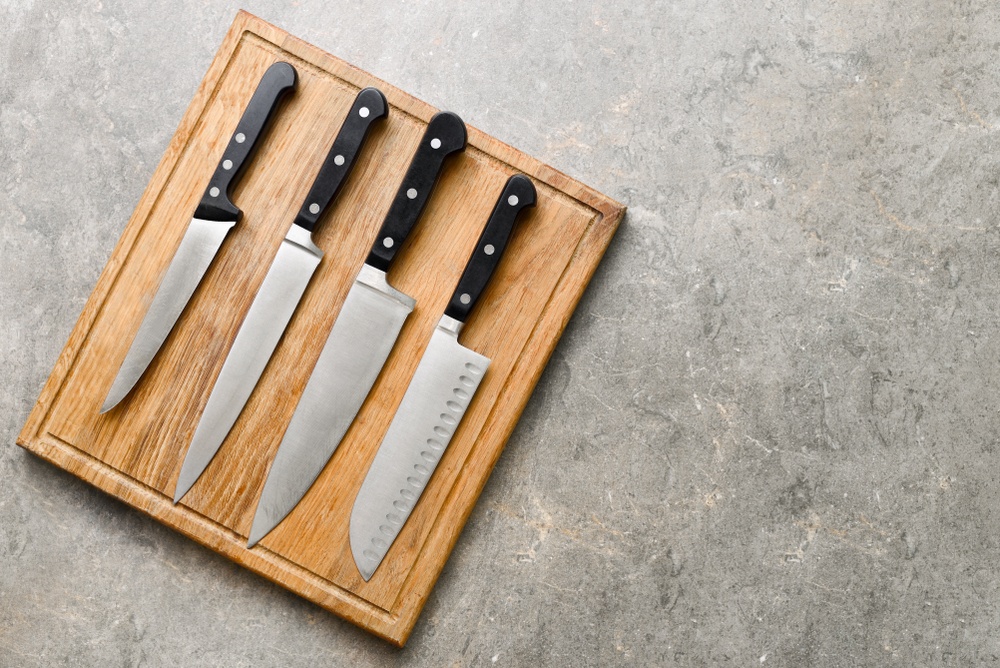
2. Before Using the Knife
Here’s another scenario to clean and sanitize your knife. It would be best if you always wash your knife before using it.
We say this because the knife blade may have attracted viruses during its redundant state. You should clean the knife before using it to eliminate the viruses. You maintain good hygiene when you make this a habit.
3. After Using the Knife
It would help if you cleaned the knife immediately after use. There may be some food particles left on the blade during the cutting process. Cleaning the knife will wipe out every food particle that has clung to it.
However, there’s a catch: you may not even see those food particles. You should still clean the knife after use, even if you do not see any food particles. You ensure safety and cleanliness when you practice this often.
But there’s even more to it:
Cleaning the knife after use prevents it from getting rust. Your knife’s lifespan also increases when you always clean it.
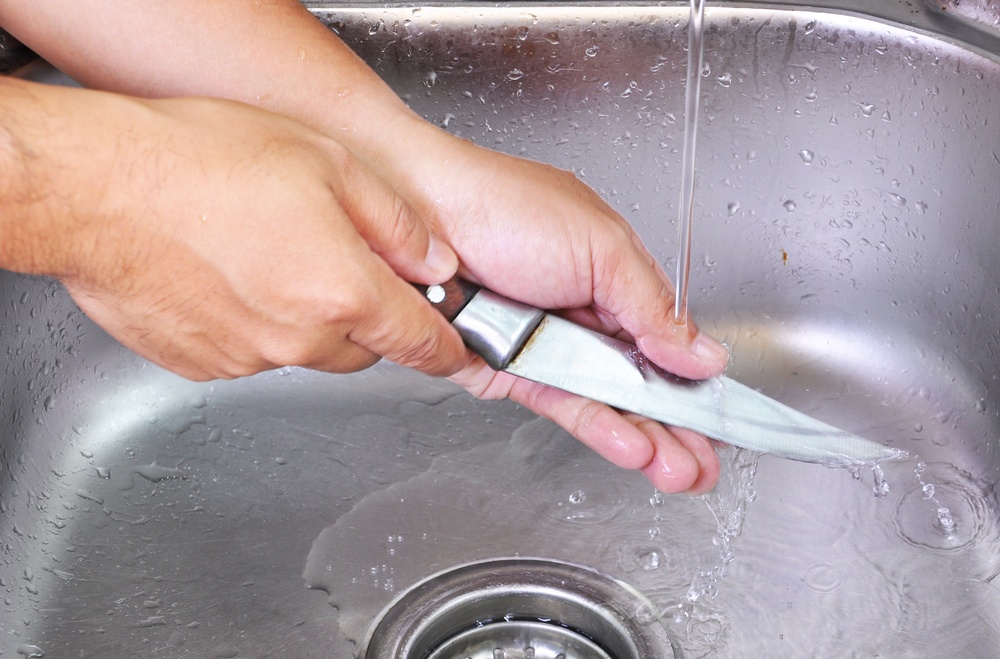
4. In-Between Use for Different Food Items
Here’s where most people miss out. You should clean the knife whenever you use it to cut different food items.
You may think this is unnecessary since all the food items will eventually go into the meal preparation. While that is true, it shouldn’t stop you from cleaning your knife in-between two uses.
More than sterilizing your knife, it is essential to properly wash all food items and kitchen utensils to prevent food poisoning.
Let’s take for instance:
You may have to cut meat, vegetables, and fish while preparing your soup. So when you cut your beef, you should wash the knife before using it to cut the vegetables, and so on.
Why does this matter?
Cleaning the knife in between use will prevent cross-contamination. Cross-contamination has to do with the transfer of bacteria and viruses from one food item to another. Therefore, you must clean the knife after cutting a food item and before cutting another one.
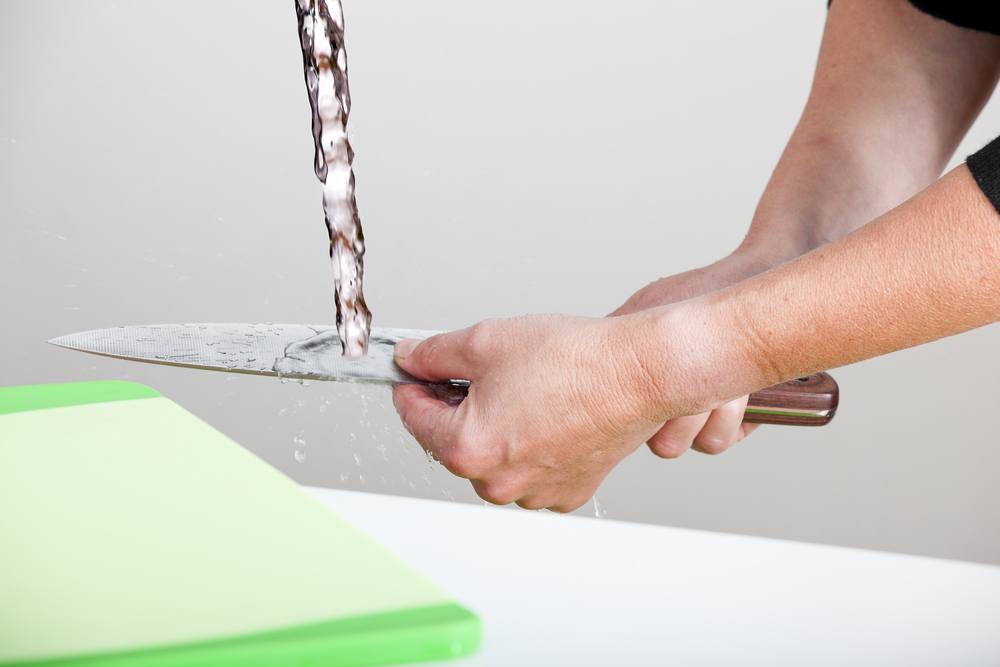
5. When Sharing the Same Knife with Multiple Persons
There may be situations where you have to share the same knife with another person.
You may not know if the other person has used the knife to cut a poisonous item that may harm you. The knife may have been used to cut a food item you’re allergic to. Using such a knife without washing may lead to health issues.
Washing the knife when multiple persons use it is one of the most compulsory scenarios to clean and sanitize your knife.
6. After Sharpening the Knife
You have to sharpen your knife whenever it gets blunt. However, most people forget to sanitize their utensils after sharpening them properly.
Using your knife directly without sanitizing may transfer germs and metal particles into your food.
Particles and debris of steel may still cling to the blade after sharpening. When you use the knife directly without washing, such particles may contaminate your food.
Do you want to avoid food contamination? Then always sanitize your knife after sharpening. Knowing how to sterilize a knife is also essential in this scenario.
Now that we’ve seen the various scenarios to clean a knife, let’s look at the different cleaning methods.
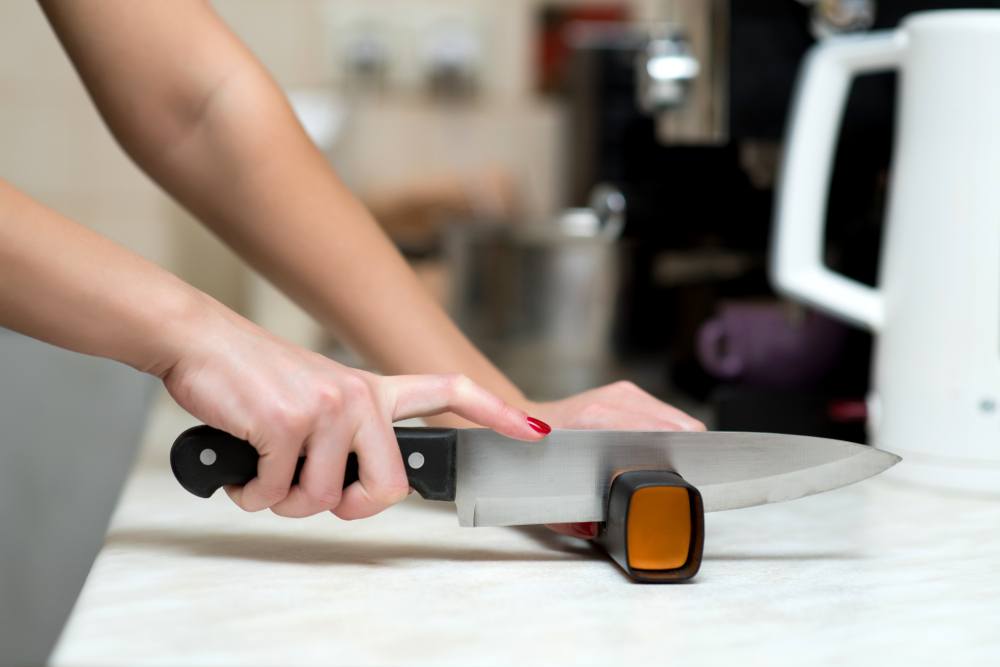
How to sterilize a knife
Washing the knife will make it spotlessly clean. However, sterilization will free it of germs and other disease-causing organisms. Here some trademark tricks to get your knife cleaned, quickly, and efficiently.
The old way
This is a simple knife cleaning method known to most chefs. It involves throwing the knife in a dishwasher or washing it with your bare hands. You may need to use a warm soap solution for thorough cleaning.
After cleaning, you may rinse the knife with a towel or leave it to dry naturally. Either way, it’s fantastic.
But, ensure you don’t wash hollow-handled knives in the dishwasher. It can damage the knife’s blade or any other kitchen utensils inside the dishwasher.
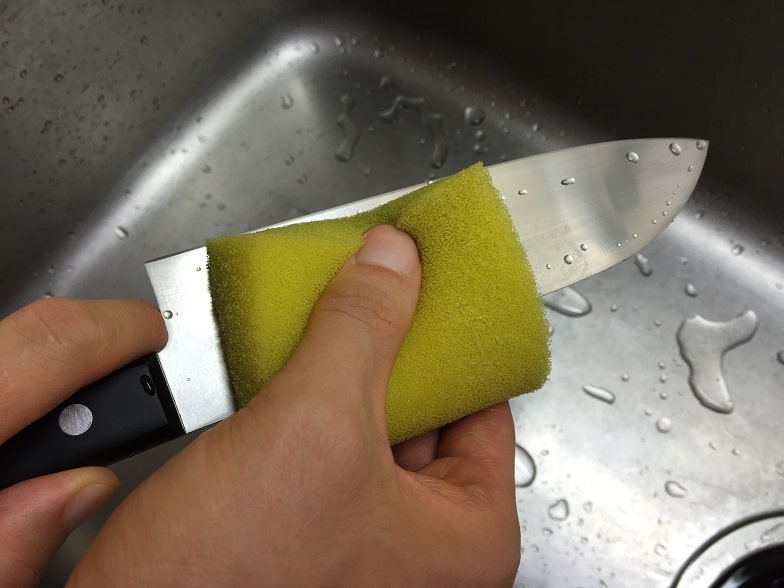
Clean with Alcohol
Alcohol and other organic solutions that kill bacteria without interacting with the knife blade may help sterilize the knife properly.
Cleaning the knife with alcohol is as simple as dipping it inside the sanitizing solution. It helps to eliminate the germs and other disease-causing organisms present on the blade.
After a few minutes, remove the knife from the solution and dry with a clean towel. For a more intense cleaning, leave it for 20-30min.
It’s probably surprising to you that alcohol can be used as a sanitizer. Well, don’t be. 95% of most hand sanitizers are made of alcohol, with a few moisturizers by the side to make them smoother on the skin.

Heating the Knife
Are you in an area where you can’t access any detergent and sanitizers? Not to worry, heating the knife is another solution to cleaning it.
Most bacteria cannot survive in an environment that is too hot or cold. So, a temperature of 40-120oC is guaranteed to get rid of those pesky germs. On the other hand, you may decide to freeze the knife too. But that’s by the way. Let’s move on.
Get a fire, and put your knife in it. Any bacteria will be inactive before you know it. You may decide to wash the knife after heating it before storing it in a cool, dry place. The choice is yours!
Use Boiling Water
Boiling water is another heat-based option of sanitizing your knife in boiling water. It’s understandable not wanting to dip your knife in a fire. The blade will become dark and unsavory. However, boiling water is another excellent option.
Boiling water (100oc) does the sanitization job pretty well. It gets rid of the bacteria and has your knife free of any infection in no time.
For best results, put the knife in boiling water for about 25min. This method is pretty unique. It’s practical and very cheap. It costs nothing to get it set up. It would be best if you give it a try.
How to Wash Knives of Different Materials
Knife blades, how to clean knife is made of different materials such as ceramic or stainless steel. This makes the way you clean knives different from each other. Follow the guide below to sanitize your ceramic and stainless knife blades.
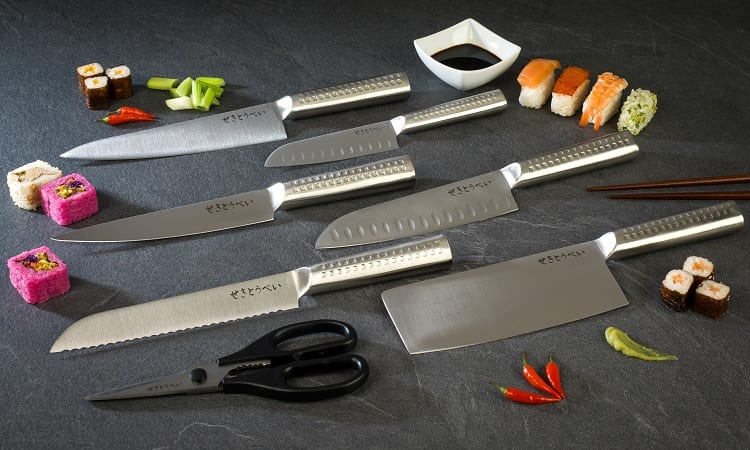
How to Wash a Ceramic knife.
Ceramics is chemically neutral. Its neutrality ensures it doesn’t rust, making your job easier.
Rinsing and air drying the knife will do the trick here. However, if some food particles are still stuck to the blade, use a towel and dishwashing soap to clean it properly.
Cleaning Stainless Steel Knives
Stainless steel is fundamentally different from ceramic steel. Its chemical components also leave it at risk for rusting. So, how do you clean the knife without making it rust?
Wash this type of knife with hot water and dish soap. Let your dish soap be mild.
Overall, you should ensure that you find out precisely the chemical contents of your knife so that you will know the best way to have it cleaned.
FAQs
What is the best detergent to use when cleaning the knife?
It would be best if you used a mild detergent or dishwashing liquid when cleaning your knife. This will ensure that your blade lasts longer.
Your knife blade can go wrong when you use an aggressive detergent. Therefore, you should use mild detergent for your knife cleaning process.
Can I wash my knife in a dishwasher?
There are some things to know about washing your knife in a dishwasher. Chief of it is that It may make the handle swell and the blade wear out.
However, if you wash the knives in the dishwasher, rinse them with water to remove any food leftovers before putting the knife in. It would be best to separate them from the rest of the cutlery when you wash them in the dishwasher.
If your dishwasher does not have a drawer or tray dedicated to cleaning cutlery, place the knife facing up. However, since the cleaning process does not take time, it is recommended that you hand-wash your knife.
My knife blade is beginning to rust. How do I wash it?
You should use a metal cleaner if the knife’s blade is beginning to rust or shows some signs of corrosion. Another option to clean the knives’ blade is to douse a cotton ball with a few drops of oil and gently clean the knife’s edge.
If the corrosion is not removed with this method, you must leave the knife soaked in oil for several days. After 3 or 4 days, you can scrape the rust off the blade of the knife. Ensure that you do not scratch or damage the knife in the process. You can also learn more about how to restore a rusty knife.
How do I wash my knife handles?
Cleaning your knife handle depends on the knife handle. If the knife’s handle to be cleaned has metal parts, you must clean it in the same way as the knife blade. Knives with plastic handles can be easily cleaned in the dishwasher.
If the knife’s handle is made of brass, you can apply a little vinegar on a cotton ball and clean it gently. Linseed oil will be the best ally to clean knives with wooden handles.
Smear some linseed oil on woolen cloth and use it to clean the wooden handles of your knives.
How can I remove food particles that have been stuck to my knife?
If you forget to clean the remains once used and the food has stuck to the blade, it is advisable to soak the knife in soapy water for a maximum of two minutes and then proceed to wash it.
Final Thoughts
knowing the various scenarios to clean and sanitize your knife is essential for the knife’s lifespan. As we have seen, taking care of your knife requires proper cleaning before, during, and after use. Regular cleaning and sanitization of the knife also help to prevent food contamination.




